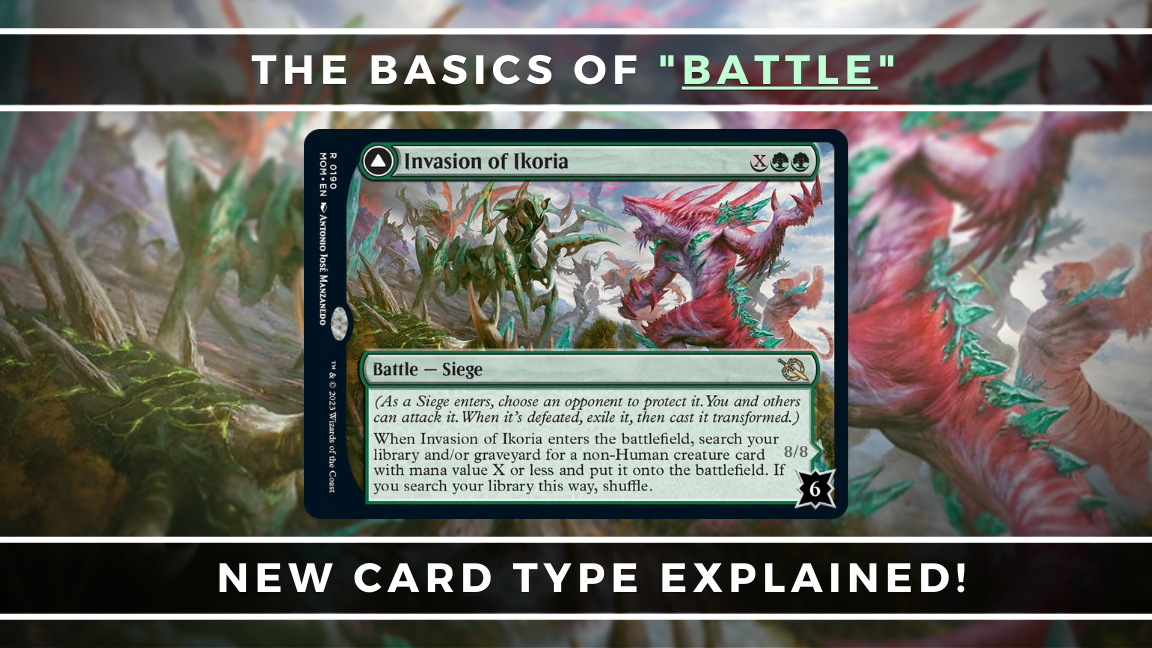The Basics of "Battle" - New Card Type Explained!

Invasion of Ikoria by Antonio J. Manzanedo
March of the Machine has had its official set debut on Wizards' YouTube channel, and we finally know enough about the new battle card type for me to give you all a basic overview of it.
Disclaimer: We don't have any rules entries or the like for battles yet, so I'm only going to be covering what I'm sure about so far. If any errors are made here, they will be corrected here and mentioned at the end of my next article.
What is a Battle?
- Battle is a new card type, like creature or instant. It was previously hinted at in the reminder text of Atraxa, Grand Unifier.
- All the battles in March of the Machine have the Siege subtype and are transforming double-faced cards.
- Mark Rosewater has said on his blog that future battles might not be Sieges and might not be double-faced cards, but for now there's only one style of battle card to worry about.
- A battle is a permanent, and you cast it like any other nonland card. Like other permanent spells, you can only cast it during your main phase when the stack is empty, i.e., when you could normally cast a sorcery. It's possible for a battle to have flash, but we haven't seen any yet.
- When a battle you cast resolves, it enters the battlefield under your control with a number of defense counters on it equal to the number in the jagged square in its lower right corner.
- As a battle enters the battlefield under your control, you choose one of your opponents to protect it. (This matters for combat and is explained in the next section.)
- A battle's protector isn't (normally) the same as its controller. It's not under their control and they can't sacrifice it. Think of it kind of like an Aura attached to the protector instead. (It's not an enchantment, though.)
- Whenever a battle is dealt damage, that many defense counters are removed from it as the result of that damage.
How Do You Damage a Battle?
There are two ways:
- Attack the battle. Any player other than the battle's protector can attack it the same way they would a player or planeswalker, and its protector can block creatures that are attacking the battle.
- Deal noncombat damage to the battle with spells and/or abilities. Some spells and abilities say that they can deal damage to a battle, and spells and abilities that deal damage to any target can target/damage a battle.
What happens when you win a battle?
- A battle is defeated when it has no defense counters on it.
- When a Siege battle is defeated, its controller exiles it and then casts it transformed without paying its mana cost.
- It doesn't matter who's responsible for defeating the battle, and there's no direct benefit to attacking a battle controlled by another player.
Example Scenario
Let's say you have Invasion of Dominaria
During your pre-combat main phase, you cast it for its mana cost. When it resolves, it enters the battlefield under your control with five defense counters on it and you choose an opponent to protect it; let's call that opponent Fred. Its triggered ability will then trigger and go on the stack. When the trigger resolves, you'll gain 4 life and draw a card.
You then proceed to combat. You choose to attack Invasion of Dominaria
Invasion of Dominaria
That's it for now, but I'll be back soon with a full overview of the new and returning mechanics of the set, as well as more technical information about how battles work. But until then, happy battling!
